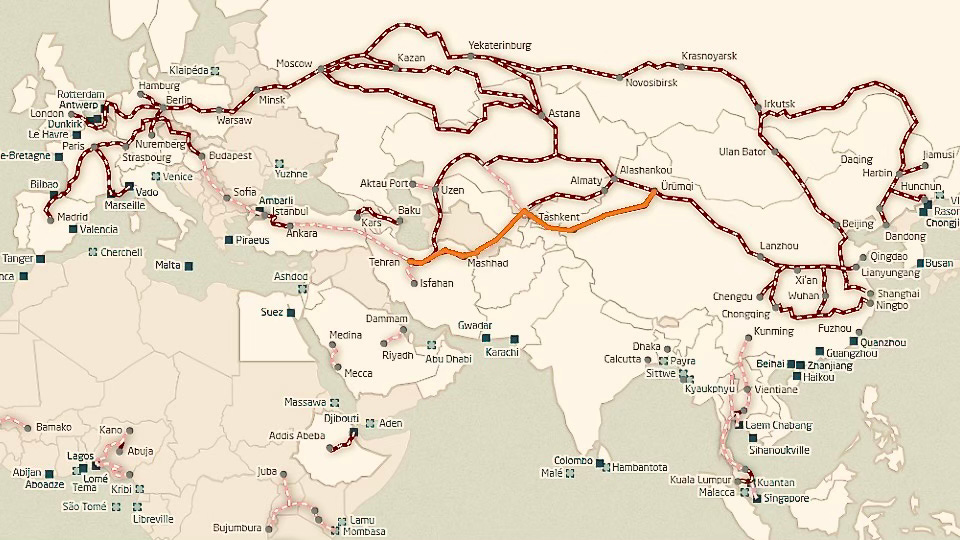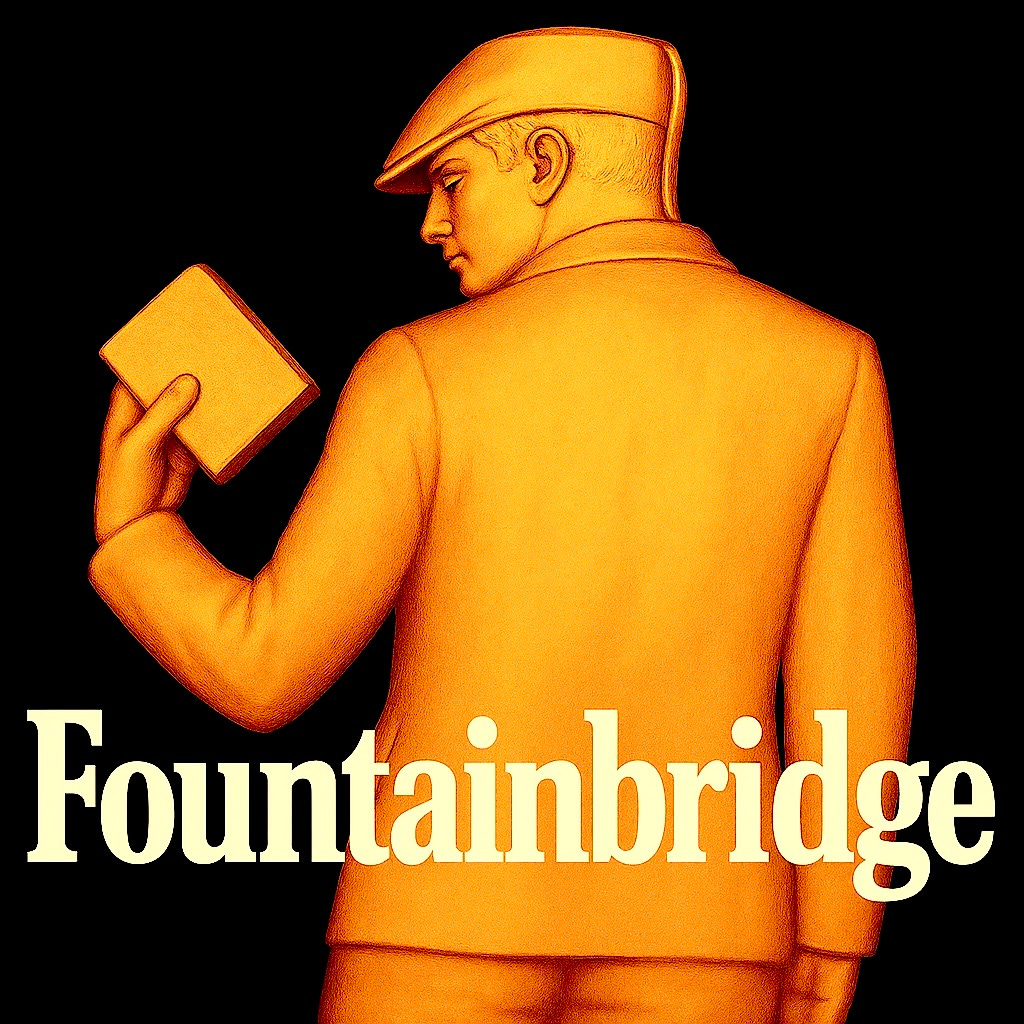China-Iran Rail Corridor Defies West’s Maritime Rule
A 7,500-mile steel artery bypassing Suez, Malacca, and Hormuz, reshaping Eurasian trade and challenging Western maritime control
This month, a pan-Eurasian container block train roared out of Xi’an — capital of Shaanxi province in central China — carrying 40-foot containers (known as FEUs in shipping jargon) full of solar panels to Aprin’s Dry Port on the outskirts of Tehran, 6,000 miles away.
It inaugurated the fully operational China–Iran rail corridor — a critical artery built to refound Eurasia’s overland trade routes, severed by Western sanctions, conflict, and maritime dependency.
By integrating rail with existing land and sea networks, Iran aims to reclaim its historic role as a regional transit hub — leveraging its geography to facilitate trade between China, Central Asia, and, eventually Europe via Turkey.
Earlier test runs — widely reported — proved the route’s digital infrastructure. But May 2025 marks the true launch — a six-nation rail corridor, treaty bound, over a decade in construction and now fully operational; the result of tens of billions of dollars invested, skilful diplomacy, purposeful planning, and hard infrastructure crossing borders.
The entire heavy-duty, high-capacity rail corridor spans over 7,500 miles, bypassing the maritime chokepoints of Suez, Malacca, and Hormuz. It welds China, Kazakhstan, Turkmenistan, Uzbekistan, Iran, and Türkiye into a seamless land bridge.
Transit times drop to 15 days — half the 30 days required by sea — slashing costs and streamlining logistics. The route plaits Central Asia into China’s new silk roads and restores Iran to its historic role as Eurasia’s pivotal connector — a natural regional transit hub, now hardened against ever more sanctions.
Trains now power along a fully electrified, double-track corridor featuring continuously welded rail mounted on prestressed concrete monoblock sleepers, secured with elastic fastenings to enhance stability and reduce maintenance.
The track rests on a precisely engineered crushed-stone ballast bed with synthetic polymer underlayers across desert stretches — designed for high-speed operation, notably on the 575-mile Tehran–Mashhad segment, rated for 125–150 mph and capable of handling over 10 million tonnes annually. Embedded sensors continuously monitor rail temperature, stress, and surface integrity, fortifying operational security.
Advanced digital signalling orchestrates real-time train control and network-wide traffic flow, supporting future driverless operation and allowing trains to run closer together. RFID-tagged wagons traverse trackbeds exceeding international standards, whilst AI based monitoring systems track wheelset wear, component stress, and the status and integrity of individual freight containers.
In tandem, AI-driven customs clearance and tariff systems harmonise procedures seamlessly across six capitals. No surprise then that container traffic is forecast to grow exponentially.
By the time Aprin’s cranes hoisted containers off the railcars, logisticians knew a new era had dawned. Aprin’s director, Homayoun Jahani, hailed its role in “slashing costs and obviating coastal bottlenecks,” transforming Iran’s largest inland dry port into a continental nexus.
Days earlier, railway chiefs from the corridor’s six nations gathered in Tehran. They codified schedules and tariffs, formalised connections with the International North–South Transport Corridor — whilst Iran’s Rasht–Astara rail link to Azerbaijan also becomes a viable alternative to the Suez Canal, long held under the West’s yoke.
Inside the Trans China–Iran railway control room, digital signals and GPS tags pulse through an all-seeing logistics grid. Semaphores flash in Chinese, Persian and Turkish — announcing a new, fully operational transport corridor, this time firmly under the control of Eurasia’s great powers. Every FEU container is geopolitically armoured — built-in redundancy against sanctions, blockades, and sabotage.
At the opening ceremony, Iran’s rail chief Miad Salehi declared: “Today, we launch the East–West Corridor — a secure gateway from China to Europe.” His deputy pledged to accelerate operations from weekly to daily runs.
China’s chargé d’affaires Fu Lihua hailed it as a continental barbican for “commercial, industrial and cultural cooperation” under the One Belt, One Road initiative. Her message was clear — this was Chinese–Iranian shared destiny, not a Western gift.
In short, this rail corridor is a secure gateway for high-value and time-sensitive freight — machine tools, electronics, military equipment — a steel-track defiance of the West’s centuries of maritime hegemony, and a hardened counter to any blockade of the Malacca Strait or disruption of sea lanes.
Make no mistake — the West grasps the stakes if Iran, not Israel, becomes the East’s gateway to Europe. That’s why, at the 2023 UN General Assembly Debate, Netanyahu unveiled the planned India-Middle-East-Europe Economic Corridor (IMEC) as “the largest cooperation project in our history,” framing it as a “blessing” — a bridge of peace and prosperity between continents. Remember that? He implicitly ensigned the China–Iran corridor not just as competition — but its antithesis.
But IMEC — with Israel as gatekeeper to Europe from the East, backed by the political, intelligence, and military trifecta of the US, UK, and Israel — was put to rout by its over reliance on maritime shipping, the absence of robust overland links, and the conspicuous exclusion of Iran and Türkiye — not to mention Israel’s wars on five fronts.
The China–Iran railway is more than infrastructure — its disruption. A calculated move against Western maritime dominance, rerouting trade away from Suez, Hormuz, and Malacca, and severing the leverage long held by distant fleets. In its place rises a new spine — one that ignites the economies of Eurasia, weakens unipolarity, and hardens multipolarity into steel, schedule, and sovereignty.
Despite this, the corridor faces very real risks. Geopolitical tensions are acute, and the railway remains exposed to sabotage — whether from domestic dissidents or foreign-backed proxies seeking to cripple critical infrastructure.
Whilst rail lines can usually be repaired rapidly, the threat is persistent. To counter it, the six participating states have established joint security protocols — recognising that in today’s world, economic sovereignty must be actively defended.
Beyond physical threats, the China–Iran railway must navigate a battlefield of diplomacy. Regional rivalries, overlapping spheres of influence, and an ever-expanding web of sanctions — always more sanctions — now aim not only to isolate Iran and Russia from global trade but to deliver a hammer blow to China itself. Washington is teeing up yet more self-defeating legislation that would impose secondary sanctions on any nation trading with Moscow or Tehran.
In this brutal reality, the corridor is no mere line on a map — it is a battleground of wills, a forge where economic sovereignty is hammered into form, and the shape of civilisational futures is sealed in motion.
What unfolds here is not just steel and logistics, but a declaration — a collective refusal to kneel before a waning hegemon, thrashing in its decline, blurring the lines between ally and adversary.
This is the forging of a new world — not in theory, but in tonnage, time, and transit. A world where power is no longer dictated by distant fleets, but seized by those who build, move, and connect.
Updated 27/05/25





Very interesting, never heard of this project before, thanks!
The Silk Railroad